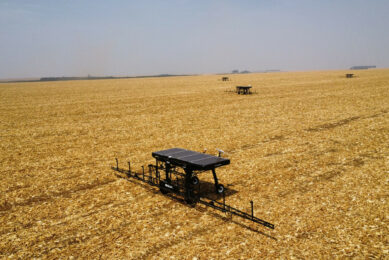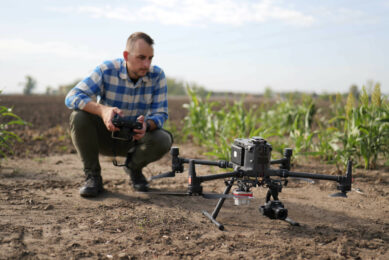Drones in agriculture: why now is the time to invest

Drones are fast becoming a crucial tool in agriculture, but how do you know if drones will be the right choice for your business? Here, Olivia Soares de Camargo, Customer Service and Satisfaction Engineer at senseFly, explores the tangible benefits drone technology can offer in the agriculture space and the key considerations to take into account before making a decision to invest in the technology.
With farmers and agronomists under increasing pressure to improve resource management and enhance product traceability, alongside rising demands in food production and consumption, the agriculture industry is at a crossroads. While traditional ground-based mapping solutions have long been used to gather insights to help address these challenges and meet growing demands, they are typically time, resource and labor intensive.
Plus, in increasingly volatile market conditions, farmers have a greater need to estimate annual yield more accurately, to help guide decision-making and manage expectations in the face of economic uncertainty.
For this reason, drones, or unmanned aerial vehicles (UAVs), have been gaining traction for their ability to gather more on-demand insights, quickly and efficiently, in a non-destructive way. For instance, they allow growers to scout entire fields without ever setting foot in the rows, which helps avoid soil compaction and the destruction of plants – while also reducing the risk of spreading pests.
Text continues underneath image

Why drones?
While drones have been used in agriculture for many years, recent developments in both UAV software and hardware have significantly improved accuracy and efficiency, making them a trustworthy and efficient data collection tool. Drones can also play an important role in streamlining workflows and processes, by saving valuable time and providing more in-depth insights to aid decision-making.
Also read: Getting started with drones
UAVs have multiple purposes not only during a season, but also before and afterwards, too. For instance, beyond mapping, drones can be used for input applications and planting. This flexibility enables farmers to collect data according to their need – or the needs of the crop. Whether that is flying in the morning and reviewing the data soon afterwards or uploading the data for deeper analysis online, it enables agriculture professionals to detect stress in the crop early and find the right location and size of the stressed area – providing more time to efficiently take action.
Text continues underneath image

Are drones right for me?
But when is the right time to invest in drone technology? There are several factors for every farmer to consider. First, return on investment is crucial. While investing in a drone can initially seem like an expensive investment, the cost-in-use benefits they can offer long-term mean that farmers can reap the rewards. Depending on the case, it is also possible to reach the breakeven point in the mid-term.
From a resourcing point of view, too, if available labor is not sufficient to map the property in question – or if the area is too large to cover using traditional measures – it may be time to seek alternative methods, such as a drone.
Finally, when it comes to crops, is productivity below expectations or irregular, with no clear explanation? Some farmers also decide to make the switch to drone technology when producing high-value crops, using a precision system, or practicing integrated pest, weed and, disease management (IPM).
Choosing a drone: 101
As the popularity of drones continues its upward trajectory, the market has become more and more competitive, which can initially make selecting the right model a complicated process. Clearly it is important to choose a UAV that suits your intended application, but there are several other factors to consider, too.
Purchasing a drone for the first time can be a daunting decision
Not all drones are created equal. Purchasing one for the first time can be a daunting decision: it needs to be easy to operate, provide high-performance and reliable data collection but at an affordable entry point.
Fixed-wing drones
Fixed-wing drones are well positioned to meet these requirements – particularly in agriculture applications where a greater coverage and longer flight times are needed. It is therefore important to first check the range of flight before making a decision. Although it is variable depending on the needs of the operation, an integrated solution of drone, sensor and software (including flight management and post-processing) is widely favored.
Some manufacturers also offer the option to upgrade to other technologies for longer flight times and increased accuracy with features such as active Real Time Kinetic (RTK)/Post-Processed Kinetic (PPK).
Text continues underneath image

What next?
The right drone needs to be easy-to-use and simple to integrate within your workflow, as well as other technologies. It must also be robust, suitable for withstanding harsh agricultural environments. How easy is the drone to transport? Ideally, your chosen UAV should be lightweight and practical for carrying between fields.
Keeping up to date with the latest regulatory changes is essential
Agriculture professionals are also advised to check that their drone is compliant with the appropriate local regulations. While there has been significant progress made in recent months to harmonize operations, drone regulations still vary significantly across the globe so keeping up to date with the latest regulatory changes is essential. Depending on the manufacturer’s standard of technical support available, it can be simple to check.
In the US, for example, the Federal Aviation Administration (FAA) requires a Part 107 certification to become a licensed drone operator and be able to fly commercially on a farm.
Text continues underneath image

Choice of drone camera
The choice of drone sensor, or camera, is also an important part in the decision-making process – multispectral and RGB sensors provide many benefits to agriculture. It can, for example, allow farmers to generate vegetation indices that highlight crop health, development and production, depending on the crop and variety. Although drones cannot replace in-person visits to the field or soil and tissue sampling, the insights gained can very efficiently direct agronomists and crop scouts to the right spot to help, which brings significant benefits to the operation.
Also read: Drone use and adoption across hemispheres
And how does this affect image processing following data collection? Because many drone flights are fully autonomous, they are a great option for removing the possibility of human error, while preserving image quality. There is also the advantage of repeatability, where users can carry out the same missions over the same fields on different dates, to compare data, monitor changes and eliminate extra variables.
Choosing RTK/PPK position referencing technology adds an even greater level of accuracy without the need for ground control points. Once the images are collected, they also need to be processed post-flight using specialized software – and the quality of the results depends on the algorithm used. For this reason, many manufacturers generate images in universal formats that are compatible with a range of post-processing software.
Achieving lift-off
While purchasing a drone may seem like a big decision, the benefits and opportunities they present farmers and agronomists alike are hard to ignore. As drone technology advances, new applications are being discovered all the time across the farm and the volume of published scientific literature exploring the best application for each crop continues to rise.
The more time that you spend using your drone in the field, the more you will understand the significance of the data
This is a prime moment in time for the agriculture space and with the right support, the use cases and options are endless. Many drone manufacturers offer online training and webinars, to help operators get the most out of their device. There is also a growing number of drone owner communities, where agriculture professionals are encouraged to exchange useful information to help enhance their operations.
Ultimately, the more time that you spend using your drone in the field, the more you will understand the significance of the data, and the easier it will be to see trends and make tangible changes in your workflow. It is an exciting time to invest in a drone – what benefits will you discover?
Join 17,000+ subscribers
Subscribe to our newsletter to stay updated about all the need-to-know content in the agricultural sector, two times a week.



